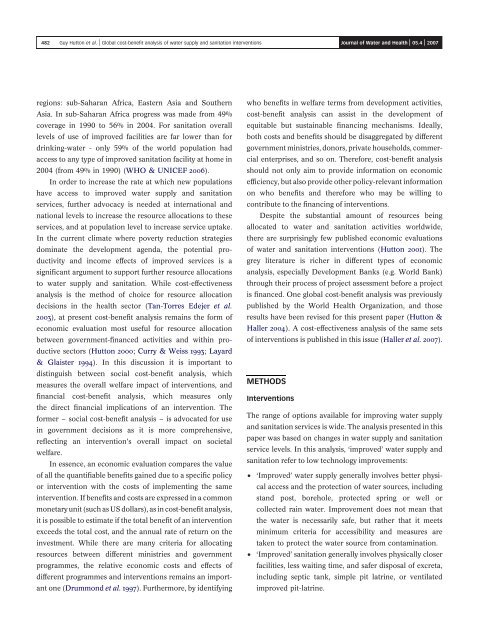Global cost-benefit analysis of water supply and sanitation ... - SuSanA
Global cost-benefit analysis of water supply and sanitation ... - SuSanA
Global cost-benefit analysis of water supply and sanitation ... - SuSanA
Create successful ePaper yourself
Turn your PDF publications into a flip-book with our unique Google optimized e-Paper software.
482 Guy Hutton et al. | <strong>Global</strong> <strong>cost</strong>-<strong>benefit</strong> <strong>analysis</strong> <strong>of</strong> <strong>water</strong> <strong>supply</strong> <strong>and</strong> <strong>sanitation</strong> interventions Journal <strong>of</strong> Water <strong>and</strong> Health | 05.4 | 2007<br />
regions: sub-Saharan Africa, Eastern Asia <strong>and</strong> Southern<br />
Asia. In sub-Saharan Africa progress was made from 49%<br />
coverage in 1990 to 56% in 2004. For <strong>sanitation</strong> overall<br />
levels <strong>of</strong> use <strong>of</strong> improved facilities are far lower than for<br />
drinking-<strong>water</strong> - only 59% <strong>of</strong> the world population had<br />
access to any type <strong>of</strong> improved <strong>sanitation</strong> facility at home in<br />
2004 (from 49% in 1990) (WHO & UNICEF 2006).<br />
In order to increase the rate at which new populations<br />
have access to improved <strong>water</strong> <strong>supply</strong> <strong>and</strong> <strong>sanitation</strong><br />
services, further advocacy is needed at international <strong>and</strong><br />
national levels to increase the resource allocations to these<br />
services, <strong>and</strong> at population level to increase service uptake.<br />
In the current climate where poverty reduction strategies<br />
dominate the development agenda, the potential productivity<br />
<strong>and</strong> income effects <strong>of</strong> improved services is a<br />
significant argument to support further resource allocations<br />
to <strong>water</strong> <strong>supply</strong> <strong>and</strong> <strong>sanitation</strong>. While <strong>cost</strong>-effectiveness<br />
<strong>analysis</strong> is the method <strong>of</strong> choice for resource allocation<br />
decisions in the health sector (Tan-Torres Edejer et al.<br />
2003), at present <strong>cost</strong>-<strong>benefit</strong> <strong>analysis</strong> remains the form <strong>of</strong><br />
economic evaluation most useful for resource allocation<br />
between government-financed activities <strong>and</strong> within productive<br />
sectors (Hutton 2000; Curry & Weiss 1993; Layard<br />
& Glaister 1994). In this discussion it is important to<br />
distinguish between social <strong>cost</strong>-<strong>benefit</strong> <strong>analysis</strong>, which<br />
measures the overall welfare impact <strong>of</strong> interventions, <strong>and</strong><br />
financial <strong>cost</strong>-<strong>benefit</strong> <strong>analysis</strong>, which measures only<br />
the direct financial implications <strong>of</strong> an intervention. The<br />
former – social <strong>cost</strong>-<strong>benefit</strong> <strong>analysis</strong> – is advocated for use<br />
in government decisions as it is more comprehensive,<br />
reflecting an intervention’s overall impact on societal<br />
welfare.<br />
In essence, an economic evaluation compares the value<br />
<strong>of</strong> all the quantifiable <strong>benefit</strong>s gained due to a specific policy<br />
or intervention with the <strong>cost</strong>s <strong>of</strong> implementing the same<br />
intervention. If <strong>benefit</strong>s <strong>and</strong> <strong>cost</strong>s are expressed in a common<br />
monetary unit (such as US dollars), as in <strong>cost</strong>-<strong>benefit</strong> <strong>analysis</strong>,<br />
it is possible to estimate if the total <strong>benefit</strong> <strong>of</strong> an intervention<br />
exceeds the total <strong>cost</strong>, <strong>and</strong> the annual rate <strong>of</strong> return on the<br />
investment. While there are many criteria for allocating<br />
resources between different ministries <strong>and</strong> government<br />
programmes, the relative economic <strong>cost</strong>s <strong>and</strong> effects <strong>of</strong><br />
different programmes <strong>and</strong> interventions remains an important<br />
one (Drummond et al. 1997). Furthermore, by identifying<br />
who <strong>benefit</strong>s in welfare terms from development activities,<br />
<strong>cost</strong>-<strong>benefit</strong> <strong>analysis</strong> can assist in the development <strong>of</strong><br />
equitable but sustainable financing mechanisms. Ideally,<br />
both <strong>cost</strong>s <strong>and</strong> <strong>benefit</strong>s should be disaggregated by different<br />
government ministries, donors, private households, commercial<br />
enterprises, <strong>and</strong> so on. Therefore, <strong>cost</strong>-<strong>benefit</strong> <strong>analysis</strong><br />
should not only aim to provide information on economic<br />
efficiency, but also provide other policy-relevant information<br />
on who <strong>benefit</strong>s <strong>and</strong> therefore who may be willing to<br />
contribute to the financing <strong>of</strong> interventions.<br />
Despite the substantial amount <strong>of</strong> resources being<br />
allocated to <strong>water</strong> <strong>and</strong> <strong>sanitation</strong> activities worldwide,<br />
there are surprisingly few published economic evaluations<br />
<strong>of</strong> <strong>water</strong> <strong>and</strong> <strong>sanitation</strong> interventions (Hutton 2001). The<br />
grey literature is richer in different types <strong>of</strong> economic<br />
<strong>analysis</strong>, especially Development Banks (e.g. World Bank)<br />
through their process <strong>of</strong> project assessment before a project<br />
is financed. One global <strong>cost</strong>-<strong>benefit</strong> <strong>analysis</strong> was previously<br />
published by the World Health Organization, <strong>and</strong> those<br />
results have been revised for this present paper (Hutton &<br />
Haller 2004). A <strong>cost</strong>-effectiveness <strong>analysis</strong> <strong>of</strong> the same sets<br />
<strong>of</strong> interventions is published in this issue (Haller et al. 2007).<br />
METHODS<br />
Interventions<br />
The range <strong>of</strong> options available for improving <strong>water</strong> <strong>supply</strong><br />
<strong>and</strong> <strong>sanitation</strong> services is wide. The <strong>analysis</strong> presented in this<br />
paper was based on changes in <strong>water</strong> <strong>supply</strong> <strong>and</strong> <strong>sanitation</strong><br />
service levels. In this <strong>analysis</strong>, ‘improved’ <strong>water</strong> <strong>supply</strong> <strong>and</strong><br />
<strong>sanitation</strong> refer to low technology improvements:<br />
† ‘Improved’ <strong>water</strong> <strong>supply</strong> generally involves better physical<br />
access <strong>and</strong> the protection <strong>of</strong> <strong>water</strong> sources, including<br />
st<strong>and</strong> post, borehole, protected spring or well or<br />
collected rain <strong>water</strong>. Improvement does not mean that<br />
the <strong>water</strong> is necessarily safe, but rather that it meets<br />
minimum criteria for accessibility <strong>and</strong> measures are<br />
taken to protect the <strong>water</strong> source from contamination.<br />
† ‘Improved’ <strong>sanitation</strong> generally involves physically closer<br />
facilities, less waiting time, <strong>and</strong> safer disposal <strong>of</strong> excreta,<br />
including septic tank, simple pit latrine, or ventilated<br />
improved pit-latrine.
















